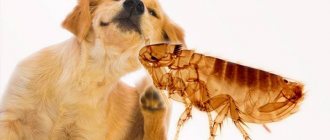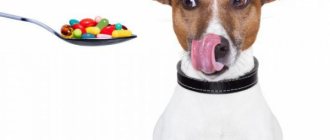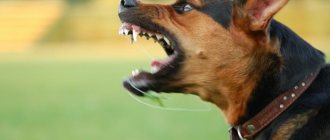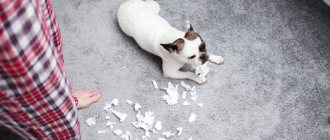Contrary to popular belief, domestic dogs suffer from flea bites not much less often than their stray counterparts. And if the latter can only adapt, the pet owner should not delay the decision on how to rid the dog of fleas. Indeed, in addition to discomfort, such a “neighborhood” provokes allergies and dermatitis in the animal, causes helminthic infestations, anemia, and exhaustion.
Often, getting rid of fleas is not an easy task even for an “experienced” owner: choosing a suitable, safe and effective method of combating the parasite requires a lot of trial and error. But the main thing to start with is to make sure there is a problem.
Causes of flea infestation
It is impossible to completely and forever protect a dog from parasites, because there are incredibly many possibilities for infection with them. Whether on the street or in the apartment, there are no safe places. Fleas can be found anywhere, even in the most unexpected places. But we can identify the main reasons for the appearance of “vampires” in animals:
- Any walks in nature or even around the city;
- Contact with other animals;
- Larvae.
In the first case, it is obvious that hungry insects are patiently waiting for victims. They have no preference in choosing where to ambush. Grass, foliage, and soil will do. They can be found on the playground, on sidewalks and on public transport. They are everywhere. And there is a simple explanation for this: an animal overpopulated with fleas throws off some of the parasites.
But the risk of having uncomfortable “guests” is even higher - communication between pets. A dog easily picks up fleas, even if it is half a meter away from an infected animal. There is also a risk when interacting with a completely domestic animal.
Larvae, like fleas themselves, can be everywhere. But they are the easiest to bring into a person’s house. On shoes or clothes along with dirt and stuck leaves.
Fleas are tenacious creatures. It is not difficult for them to move freely from one place to another in search of food. They can get into the house through open windows and doors, and even in women's handbags or grocery bags.
IMPORTANT: Fleas are often confused with lice. They are easy to distinguish: the body of lice is usually large and flat, and the legs are short. Fleas are brown in color and lice are grayish-white. The latter are less common, mainly in unkempt pets and stray dogs.
Flea classification
It is difficult for a non-specialist to distinguish one type of flea from another, because to the eye they look the same. But the flea classifier includes many families and species of these insects.
Most often, it is generally accepted to separate fleas according to their choice of prey: human, cat, rat, etc. There is also Ctenocephalidis Canis - this is the so-called dog flea. In fact, not only this species, but also many other species parasitize the dog.
The human flea feeds on the blood of both humans and their domestic animals. They are saturated with blood in 20 minutes, and then digest it for another six hours.
IMPORTANT: Subcutaneous fleas are a myth. There are many parasites that live under the skin, but fleas are not one of them. Duck mites are also mistakenly mistaken for fleas.
- The cat flea also parasitizes other animals and humans.
- A dog flea is similar to a cat flea, but lives a little less (six months to one and a half years). These insects are sources of flatworms and plague.
- More dangerous than the previous ones is the rat flea. She is a carrier of rat and mouse tapeworm.
- The black flea, unlike, for example, the dog flea, reproduces very quickly: the time from being in the larval stage to becoming an adult is barely four days.
- There are grass fleas that are mistaken for other species of fleas. Unlike the others, the grass one has wings, albeit barely noticeable. It is active from mid-spring to mid-summer, but there are exceptions. If you don't get rid of it in time, it can bother you all year round.
IMPORTANT: Grass fleas often inhabit vegetable gardens and eat plants. But this does not mean that they are harmless to humans and animals.
Another special species is the bed flea. Already from the name it is clear where it lives.
Read Causes of hematobartonellosis in dogs: signs and methods of treatment
How fleas reproduce on dogs
The peculiarity of their reproduction is that in cold weather they prefer not to mate. The ideal temperature for this is 18-25 degrees. Mating itself takes several hours, so it does not happen on the dog’s body, but somewhere in a secluded corner.
The life cycle of these bloodsuckers includes four stages:
- Egg. The female lays them little by little: only 4-8 eggs at a time. Eggs rarely remain on the pet itself; they usually fall to the floor due to their non-stickiness.
- Larva. The dog flea hatches after 8-14 days and begins to feed on the excrement of adults. She needs excrement because it contains undigested blood. Their diet also includes other waste, including rotted grass.
- Doll. After two molts, the pupa weaves a cocoon, which subsequently sticks to it. The flea remains in this stage until a victim appears nearby.
- Imago. Adult stage. Their lifespan greatly depends on the conditions in which they live. At low temperatures they live longer.
Popular questions and answers
We talked with veterinarian Natalya Grishaeva about the problem of fleas in dogs - she answered the most pressing questions from owners.
What are the signs of a flea infestation?
If your dog starts scratching and biting his fur frequently, check to see if he has contracted fleas. To do this, rake the fur or examine the dog's belly, where the fur is very sparse. You should be alerted by black crumbs caught between the hairs - these could be flea eggs. In case of severe infestation, you will see the parasites themselves.
How can you tell if your dog has fleas and not a tick or an allergy?
A distinctive feature of flea infestation is that the dog is always itching in different places, because these parasites live on its entire body and bite, accordingly, everywhere. While the animal scratches the tick in one place (most often the ears). Allergic manifestations also usually have a permanent localization.
Why can't you see fleas on a dog?
Fleas are extremely small insects. Their body length rarely exceeds 0.5 mm, and they look like black dots. In addition, fleas constantly jump and often match the color of the dog's fur. So, if your dog is dark in color, do not even try to see if he has parasites. But in the white and not very long fur of these insects it is quite possible to see and even catch.
How dangerous are fleas for dogs?
They are carriers of pathogens of many diseases, the main ones being plague and brucellosis. Fleas are also infected with roundworms, nematodes, and tapeworms. Flea saliva often causes an allergic reaction in dogs. And they can simply bleed small puppies dry. And, of course, a dog that itches constantly becomes nervous, it stops sleeping normally and even eating.
Are fleas dangerous for humans?
These insects do not live on humans, but, as mentioned above, they can bite. And like all blood-sucking animals, they are carriers of various dangerous infections, for example, typhus, hepatitis, salmonellosis and others.
What to do if your dog’s fleas don’t go away?
Today, in any pet store or veterinary pharmacy you can buy a lot of flea medications.
It is also important to treat the dog’s housing: kennel, enclosure and bedding. If all measures have been taken, but the parasites do not go away, you should definitely contact a veterinarian so that, after conducting the necessary tests, he can select the flea drug that is right for your dog. Sources
- Smyslova P.Yu. Modern range and mechanisms of action of insectoacaricides for small domestic animals // Current issues of veterinary biology, 2013, https://cyberleninka.ru/article/n/sovremennyy-assortiment-i-mehanizmy-deystviya-insektoakaritsidov-dlya-melkih-domashnih-zhivotnyh
- Kruglov D.S., Stolbova O.A. A method of protecting dogs from flea infestations // Theory and practice of combating parasitic diseases, 2020, https://cyberleninka.ru/article/n/sposob-zaschity-sobak-ot-bloshinyh-invaziy
- Glazunova L.A., Tkacheva Yu.A. Comparative effectiveness of drugs for flea infestation in dogs and cats // Veterinary Doctor, 2017, https://cyberleninka.ru/article/n/sravnitelnaya-effektivnost-preparatov-pri-bloshinoy-invazii-sobak-i-koshek
Symptoms and external signs
The main symptom is the dog’s anxiety: it tends to change its position while resting, twitch, and jump up. A flea-covered dog stops loving bathing. Any entry into the water evokes an irresistible desire to get out onto land.
An obvious sign is that the animal has bitten itself, scratched itself furiously, and its eyes are filled with irritation or anger.
Other signs are visible when scratching: red spots on the skin (this is not an indicator if the dog has allergies), eggs and excrement on the fur. Wounds and areas with ulcers also indicate possible infection.
Fleas bite in their favorite places - the withers, ears and stomach. That's where you should look for them first.
Diathesis and its causes
Atopic dermatitis (diathesis) is the most common allergic skin disease in children and adults, which is characterized by inflammation, itching, and a chronic relapsing course. Atopic dermatitis typically has different skin manifestations depending on the person's age. Let's look at it in more detail below.
Atopic dermatitis (diathesis) is the most common allergic skin disease.
Causes of diathesis
A special role in the development of the disease is played by the hereditary ability to develop allergic diseases.
The disease is also based on other causes, which can be divided into internal and external. Internal characteristics include the characteristics of the organism itself. External causes include those with which a person comes into contact from the outside.
Internal reasons
- Hereditary – determined ability of the body to increase the production of IgE (immunoglobulin, responsible in most cases for allergies).
- Increased, excessive reaction of the skin to irritants (allergens).
- Increased skin dryness.
- Violation of the epidermal barrier.
External reasons
- In children of the first years of life - food allergies, as well as intestinal dysbiosis, vaccination (DPT). It is important to emphasize that vaccination will not lead to the development of atopic dermatitis in every child. There is only a higher likelihood of developing this disease in children with a history of allergies.
- Preschool children have household and fungal allergens. Often the cause can be helminthiasis.
- In adolescence – stress, emotional experiences.
- The causes of diathesis in adults are a combination of the factors described above. This could be a food allergy, an allergy to flowering plants, a contact allergy (when allergens come into contact with the skin), stress, or emotional distress.
The danger of fleas for dogs and humans
In addition to discomfort, the dog has a risk of getting sick or becoming infected with something else. Fleas are especially dangerous due to the following consequences:
- Plague;
- Infestation by tapeworms and other parasites;
- Typhus;
- Ulcers, including anthrax;
- Allergy;
- Brucellosis;
- Listeriosis;
- Anemia;
- Fungal infections;
- Encephalitis;
- Salmonellosis.
Fleas will not spread to humans, but if they bite, they will bite. Accordingly, the owners have the same risks.
What is a flea
The “blood connection” between the ancestor of the dog and the flea arose even earlier than the appearance of Homo sapiens on earth - approximately fifty-five thousand years ago. Of the huge number of subspecies, the “dog flea” lives on dogs - a small (up to 5 mm) brown insect with a flattened body without wings. The structure of the body and three pairs of legs allow the parasite to easily jump on the “victim”, move quickly, hide in the fur, and, if necessary, jump to another owner or temporary carrier.
Important! Fleas reproduce quickly: the population increases to two hundred and fifty adults in a couple of weeks. The dog, its bedding, home carpets, and upholstered furniture are infected. They will also have to be processed.
How to remove fleas from a dog
Getting rid of them should begin immediately from the moment the “vampires” are discovered. When a dog is literally eaten by fleas, much more serious and expensive treatment may be needed.
Shampoos
Most harmless and suitable for puppies. Especially those based on natural ingredients. Insecticidal shampoos easily cause allergies.
For thorough flea removal, it is better to use something else.
Popular shampoos: “Doctor Zoo”, “Bars”, “Clandestine”, “Beaphar”, “Master Bruno”, “Lugovoy”, “Fitoelita”.
You can make your own shampoo. They do it like this: rub baby soap, pour in three glasses of water or a decoction of herbs (it can be wormwood, geranium or lavender), cook over low heat until thick, cool, add three egg yolks to everything. If desired, add essential oil (any effective one). It must be used immediately: lather and leave for ten minutes, then rinse with vinegar, strongly diluted with water.
Read Signs of allergic otitis media in dogs: best home treatment methods
Sprays
Among the advantages is the ability to destroy insects over a large area at once. This option is inconvenient, as it imposes some restrictions:
- After use, you must not wash your dog for two days;
- Handling must be done with gloves;
- It is necessary to ensure that the dog does not lick the product;
- It is recommended to use outdoors or in a well-ventilated area.
Popular sprays: “Bars”, “Hartz”, “Beaphar”, “Frontline”.
Drops
Flea drops have gained popularity in the market due to their strong insecticide properties. They last for about a month, protecting your pet from re-infection. Apply on the back between the shoulder blades and sacrum. As with the spray, the dog is not washed for two days.
Popular drops: “Stronghold”, “Bars”, “Practik”, “Clandestine”, “Frontline”, “Advocate”, “Blokhnet”, “Advantix”.
If a dog has fleas, along with their destruction, it is imperative to disinfect the living quarters, the pet's kennel and those areas of the house that the animal visits. Suitable for this purpose are washing floors with wormwood infusion, cleaning carpets with baking soda and table salt (tromped into the carpet and left overnight).
Chewable tablets
Lozenges and tablets are not recommended for puppies under 14 weeks of age. They contain an insecticide that enters the bloodstream. This method of control is rarely resorted to - the death of the flea does not occur immediately and the owners have no desire to feed their pets poison.
Popular tablets: Sentinel, Capstar, Bravento, Comfort, Frontline.
Anti-flea collars
This remedy has a greater advantage in prevention than in the fight against an already large mass of parasites. Chemical collars are used for control. For the prevention of pregnant dogs - ultrasound and biological. The latter contain essential oils and plant extracts.
IMPORTANT: Insecticidal collars can cause harm to the animal. They have many contraindications that you should definitely familiarize yourself with.
The peculiarity of the collars is that they can be worn from two months to six months.
Popular collars: “Clandestine”, “Beaphar”, “Leopard”, “Doctor Zoo”, “Bolfo”.
Insectoacaricide powders
A budget option, but time-consuming. Like many products used to remove fleas, these powders are toxic. The method of applying the powder depends on the instructions.
Could your cat have lice, where do they come from? Symptoms of infection
The problem of lice infestation is especially acute for cats that occasionally go outside for a walk. By communicating with its relatives, a pet can easily “catch” an unpleasant disease.
The following symptoms indicate whether your cat has lice:
- Dry, loose fur;
- Baldness of some areas of the skin;
- Itching;
- Anemia.
You can find out if a cat is infested with lice by carefully examining your pet's skin and fur. Nits and adults of these parasites are visible to the naked eye.
- Shampoos for external parasites Special zoo shampoos for ectoparasites have a detrimental effect on lice. After soaping the animal, the shampoo should be left on the pet for at least 10 minutes and only then rinsed thoroughly. Then it is recommended to comb the cat and dry it. If your pet tolerates the bathing procedure calmly, then washing with zoo shampoo will not give him any unpleasant sensations.
- Collars against fleas, lice, ticks Collars destroy lice on an animal and protect the pet from re-infection. However, often with constant wearing of such a collar, animals experience an allergic reaction.
Folk remedies for fleas
Sometimes toxic drugs are contraindicated for a dog, for example, during pregnancy. Then it is better to resist blood sucking at home, using folk remedies.
Herbs
The best assistant here is wormwood. It is rubbed into the pet’s fur in the form of a decoction, and the floors in the house are also washed with it. An alternative is tansy.
In rare cases, they resort to celandine, but with caution - it is toxic. It is infused with vodka and dripped onto the withers. Another option: use it to rinse your pet’s fur after a bath.
Another way to use herbs: pour tansy (1/4), eucalyptus (1/4) and wormwood (2/4) with boiling water overnight. And in the morning, walk around the house with a spray bottle.
Garlic
It is crushed and strained in boiling water, rubbed into the withers, and sometimes distributed over the back. It is added to food, but in small portions, as it is poisonous to pets.
Onion
It helps well when washing if rubbed and mixed with baby soap. Together with garlic, it can be applied to the withers in the form of a paste.
Laundry soap
When there are no necessary shampoos, they resort to soap, preferably tar. You need to make sure that it does not lead to dry skin. This soap is used to wash floors and everything the dog sleeps on.
Essential oils
They are added to shampoos, combined with tar soap and applied to animal bedding. These are mainly citrus fruits, geranium, mint, lavender, cloves, anise, fir, tea tree and eucalyptus. Should be used with caution: dogs do not like strong odors.
Needles
The animal's sleeping place is filled with sawdust. They can also serve as a replacement for bedding: just fill the mattress with them.
Read Signs and treatment of ataxia in dogs: 3 types of disease
Vinegar
Suitable for small pets. The dog's entire body is sprayed with vinegar, then placed in a bag, except for the head, and kept there for about five minutes, then washed. It is necessary to ensure that the vinegar does not get into the eyes, nose and mouth of the animal and is rubbed into the roots of the fur.
For small breeds, salt is also suitable: a kilogram of salt is dissolved in a bucket of warm water, and the pet is dipped into this water for a few minutes. If desired, replace the salt with wormwood or another effective plant against fleas.
Other folk remedies include:
- Kerosene. They cannot treat the animal's body, but they can treat those places where fleas have been noticed. After rubbing kerosene into floors and other surfaces, leave it for a day, then ventilate thoroughly.
- Ammonia. They also treat the room. Ammonia is also supposed to be used to rinse the dog after bathing.
- Hellebore water. This tincture is used to treat the hair only if the dog does not have open wounds or scratches. Application to mucous membranes is not allowed.
- Hydrogen peroxide. Not suitable for show dogs, as the coat changes structure and becomes lighter. Peroxide diluted with water is applied to the wool and left for 25 minutes, then rinsed off.
- Camphor alcohol. Mix with table vinegar and a small dose of cologne. Apply before bathing, sometimes spray around the house.
- Boric acid. This relatively safe product destroys chitin, which is vital for fleas. A solution is made with this acid.
- Juniper fruits. Pour boiling water over two hundred grams and leave overnight. Used as drops against fleas.
Animal handling rules
When a dog is diagnosed and prescribed a remedy, you must strictly follow the prescribed dosage and frequency of treatment with an insectoacaricidal agent.
How to use medications correctly:
- Shampoos. First, the pet is combed with a brush with thick bristles, then bathes for 5 minutes in the bathroom. Water for water treatments should be 37 degrees. You can treat wet wool with the product, lather it, and rinse off after 5 minutes. The dog's coat must be completely dry after bathing, so the animal must remain in a heated room all this time.
- Drops should be applied from the back of the head to the withers of the animal. In this case, you need to part the fur so that the drug gets on the skin. Next, the active substances penetrate the skin, then into the bloodstream, providing an antiparasitic effect. The procedure is carried out using rubber gloves. To prevent licking of the product, the pet is wearing a protective collar.
- The spray is applied by sprinkling evenly over the dog's body. The head is not sprayed, so as not to accidentally spray into the eye area or mouth. For better penetration of the medicine onto the skin, the fur should be straightened with your hands. When the product is applied, the dog needs to be occupied so that he does not lick himself. Even though it is a chemical, like any medicine, there is an acceptable amount that can be accidentally ingested.
- The powder is used in rare cases. The entire animal is treated so that the substance gets on the skin, except for the genital area and muzzle. After treatment, the dog's fur is combed out using a thick brush.
- Chewable tablets are given to the dog in the required dose according to the instructions, which the dog should eat along with food.
- Flea collars are worn after the animal has been rid of parasites to prevent relapse. It is important to strictly observe the timing of wearing the collar and change it in a timely manner.
- The injections are prescribed by a veterinarian and administered in the clinic. Unauthorized treatment with injections is unacceptable.
Regardless of the drug chosen to remove insects, the animal must be given antihistamines.
Prevention
To ensure that fleas visit your dog much less often, you must follow these rules:
- Periodically disinfect the room, change and wash sleeping places;
- Vacuum carpets, cracks in the floor, burn disposable dust containers, and put an anti-flea collar in a reusable one;
- Keep contact with other animals to a minimum;
- Monitor your pet's behavior;
- Brush his coat regularly, preferably with a flea comb or a metal comb with firm, fine-toothed teeth;
- Walk in specially designated areas;
- Keep calamus leaves or branches of wormwood and tansy in the corners of the house, but only if the pet does not have allergies;
- Ventilate the house in winter - fleas cannot stand the cold;
- During the summer months, wear a flea collar before going for a walk;
- Be sure to examine the dog after mating or upon returning from a show.
If fleas are found on one of your pets, you will have to treat every single one of them, even if they show no signs. This is a necessary part of prevention.
Some owners begin to fight parasites only if they have already multiplied with might and main. They believe that fighting small insects is the same as going to drink tea. Indeed, sometimes this turns out to be simple, especially if the house is small and there is only one dog living in it. But we must remember that the struggle is not always easy, and the pet can literally experience agony.
Taking flea prevention is the responsibility of every dog owner.
Chemicals
Drops are the easiest to use dosage form of anti-flea drugs. They are applied to the withers area, the bottles are equipped with a special dispenser, so they are easy to use. After the procedure, the pet must avoid contact with water, it cannot be bathed, or even left near the bathtub; it may climb into the water on its own due to severe itching.
The most common flea drops for dogs are:
- Stronghold. The advantage of the drug is that it is safe to use; it is not toxic to either dogs or people. Even if your pet accidentally swallows the product, nothing will happen. Apply a few drops of the product to the withers area. For 30 minutes it is necessary to rid the dog of contact with any people or animals.
- Leopard. Drops from a domestic manufacturer, the main advantage of which is low cost. The package contains 4 dropper pipettes. The dosage is calculated according to the instructions, for example, one pipette is indicated for dogs weighing up to 10 kg, two pipettes for dogs weighing up to 20 kg. The leopard is applied to the withers area, between the shoulder blades. For use in a long-haired dog, the dose can be increased by 1.5 times.
- Frontline. The dosage of the drug is calculated based on the weight of the pet, similar to the previous Barsu drops. If fleas are infested on a dog weighing from 2 to 10 kg, the recommended daily dosage is 0.6 ml, up to 20 kg - 1.34, up to 30 - 2.68, up to 40 - 4 ml (full pipette).
Tablets are usually prescribed as an addition to the use of drops. This ensures effective control of parasites both externally and internally. Common tablets are:
- Tsapstar. The active ingredient of the drug is nitenpyram, which is a powerful insecticide. The tablet should be given to your pet after a meal; you can add it to your favorite treat. Within 15-20 minutes, nitenpyram will have a detrimental effect on parasites.
- Comfortis. After the tablet enters the dog’s stomach, its components are absorbed into the mucous membrane and then penetrate into the blood. When the drug enters the body of the parasite, it has a depressant effect on the nervous system, which leads to the death of the flea.
To remove flea eggs, you need to use drops; tablets are powerless for this, so they rarely form the basis of treatment.
When treating fleas with a drug in tablet form, it is important to adhere to proper feeding of the pet and avoid prohibited foods. Such drugs have a negative effect on the stomach.
Anti-flea shampoos
Shampoos are the best way to combat fleas in a small puppy. Most drops, tablets, sprays, and drugs in other dosage forms are contraindicated in dogs under 2-4 years of age. Such shampoos are Mr. Bruno, Beaphar Bea Flea Shampoo.
Many shampoos can be used for adult dogs in addition to drops and tablets. The most common ones used are:
- Phytoelite. Affordable shampoo from a domestic manufacturer. The product is based on medicinal herbs, which makes its use safe. First, you need to wet the wool with warm water, apply shampoo for 3-4 minutes, foam it, rub it with massage movements, and rinse with running water.
- Doctor ZOO. It also has a natural base. The shampoo is applied in the same way as the previous one: wet the hair with warm water, apply, foam the shampoo, rinse with running water.
- Lugovoy. The advantage of the shampoo is that the manufacturer’s line consists of three series. They are intended for dogs of all breeds (the most universal option), for wire-haired, long-haired animals. The product is used according to the standard scheme.
Some dogs cannot tolerate bathing; it is very difficult to lather the shampoo and keep it for some time. In such cases, you can use the product differently: dissolve a small amount in water, foam it, and bathe your pet in it. This method is convenient to use with a yard dog if you bathe it on the street.
Features of the use of chemicals in puppies and pregnant bitches
For some categories of dogs, the use of standard flea control products is unacceptable. First of all, this applies to children. When fleas are found on a newborn puppy, they are often found on a nursing dog. Parasites do not miss the opportunity to move from the fur of an adult animal to a small one.
It is recommended to use shampoo designed for children. If your puppy has parasites at 1 month of age, Mr. Bruno. Its use will not cause discomfort to your pet; it has a pleasant structure and green tea aroma. You need to lather the puppy for a few minutes, then rinse off the product with water.
If fleas are found on a one-month-old puppy, before using shampoos or any other products, you must stop breastfeeding.
Removing fleas from a pregnant dog also requires a special approach. To treat it, you cannot use chemicals; the best option would be plant-based shampoos.
In both cases, the use of folk remedies will be useful. You can thoroughly rub the wet fur of a puppy or pregnant bitch with tar soap, foam it, leave for 15-20 minutes, and rinse with running water. To ensure that the waiting time passes without problems, small puppies are usually wrapped in a diaper, and adult bitches are lured with their favorite quiet game and delicious food.
Reviews
All this is very tedious, you need to tinker. And even neutralize the house if the dog has fleas! At first I fought with all the means I could, but they still appear from somewhere. I had to spend money on ivermectin - it is injected intramuscularly. Everything has been fine with my Gadget for several months now!
Our dog doesn't like collars. Always trying to take them off, naughty. We also tried aerosols, but then the whole apartment stank. He is allergic to pine needles, but wormwood helped. Only we didn’t just wash the floors with it, but scattered the dried stuff in the corners. No further processing is needed. Sometimes we still drip, but that's just how it is
Why are dog fleas dangerous?
Firstly, their bites cause severe itching. The dog is constantly itching, anxious, uncomfortable, and in a bad mood.
Secondly, fleas are carriers of pathogens of dangerous infectious diseases: typhus, encephalitis, plague, etc. They carry helminth eggs and other pathogenic microorganisms.
Flea bites also cause severe allergic reactions. After them, irritation appears on the skin and it turns red, hurts, and swells.
Many people think that fleas from dogs are not transmitted to humans. This is true: dog fleas do not live on people. But they bite people. And their bites are unpleasant, causing severe itching and allergic reactions. And if a person is bitten by an infected flea, it can infect him.











